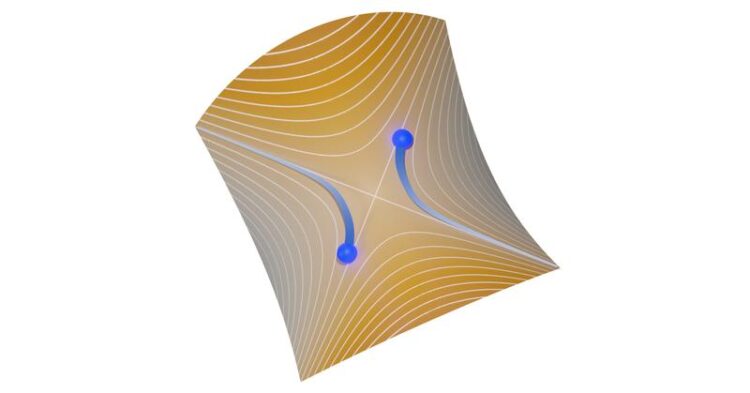Electron collider on a chip

Simulation of the electron trajectories after a collision in an electronic beam splitter
Credit: Physikalisch-Technische Bundesanstalt (PTB)
Electrical current is a stream of charged elementary particles. In semiconductor devices, ballistic electrons move at high speeds, making it difficult to address them individually. A controlled collision of individual electrons can provide the time resolution required for one electron to interrogate the other. The operating principle of such an electron collider circuit is similar to hitting one fast moving projectile with another well-timed shot. The challenge is therefore to precisely synchronize two individual electrons to exploit their interaction.
For this purpose, scientists at PTB have now developed a nanoscale collider on a semiconductor chip. Such a device integrates two single-electron sources that can be triggered to picosecond accuracy. Single-electron detectors record every outcome of the collision. An electron pair is generated by two separated sources and placed on intersecting paths such that a collision can occur. If the sources are precisely synchronized, the interaction between the electrons of the pair will determine which final signalling path will be reached by which individual particle.
Despite the brevity of the encounter, the theoretical models developed at the University of Latvia with inputs from the Technical University of Braunschweig made it possible to infer electron trajectories from the experimental data and devise ways to control two-electron interaction for future applications. This demonstration of time-resolved interaction not only shows that such a flying electron can be used as an ultrafast sensor or switch, it also proves a mechanism to generate quantum entanglement—a key component of quantum computing.
Appearing jointly with the consistent findings of research teams led by NEEL and NPL, these results have been published and introduced by a “News&Views” commentary in Nature Nanotechnology (https://www.nature.com/articles/s41565-023-01389-0).
Journal: Nature Nanotechnology
DOI: 10.1038/s41565-023-01370-x
Method of Research: Experimental study
Subject of Research: Not applicable
Article Title: Two electrons interacting at a mesoscopic beam splitter
Article Publication Date: 11-May-2023
Media Contact
All latest news from the category: Information Technology
Here you can find a summary of innovations in the fields of information and data processing and up-to-date developments on IT equipment and hardware.
This area covers topics such as IT services, IT architectures, IT management and telecommunications.
Newest articles

Detector for continuously monitoring toxic gases
The material could be made as a thin coating to analyze air quality in industrial or home settings over time. Most systems used to detect toxic gases in industrial or…

On the way for an active agent against hepatitis E
In order to infect an organ, viruses need the help of the host cells. “An effective approach is therefore to identify targets in the host that can be manipulated by…

A second chance for new antibiotic agent
Significant attempts 20 years ago… The study focused on the protein peptide deformylase (PDF). Involved in protein maturation processes in cells, PDF is essential for the survival of bacteria. However,…





















